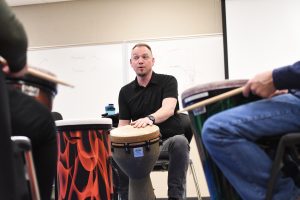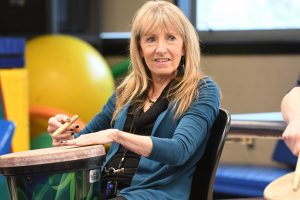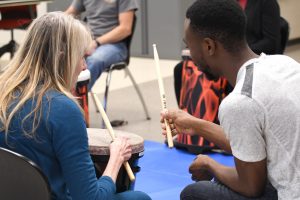
What difference can purchasing a set of drums and accompanying instruments make? Honestly, the full answer is unknown, but we do know the possibilities are endless when compassionate and passionate hearts come together. We also know where this story begins. It begins during a casual conversation over dinner ideating about the future, mapping out a plan on a napkin, and sharing the idea with others.
Dr. Sue Klappa & Dr. Don Walsh were sharing stories and discussing ideas one night over dinner when they began to conceptualize how they might address the issue of chronic pain and combat the increased prescription of medication, especially opioids, to mitigate the pain. As physical therapy educators well-versed in traditional methods of treatment of pain and management strategies, they wondered about the impact of using different approaches to reducing chronic pain. The conversation soon turned to a previous experience in recreational group drumming, and they began to opine about a potential connection between drum circles and reduction of pain. The idea alone would not provide the answer or a counter to pain medication. It would require a collaborative interdisciplinary effort, university approval, and community engagement.

Dr. Walsh, an associate professor in the University of North Georgia’s physical therapy department, brought the idea to his colleagues across campus in the music department. The music department already had an interest in music therapy, and Steven Walker, a limited-term faculty and adjunct professor of percussion, was open to the collaborative development of a drumming music therapy program. They developed the idea and presented it to the department and university leadership for approval. They were not only given freedom to proceed forward but were highly encouraged to move forward.
It not only fit the fabric of the physical therapy and music departments but the overall mission of the university. The University of North Georgia was in the process of further outlining their mission of authentic engagement with the communities in which they are represented. In the fall of 2018, they published a civic action plan providing a map for improving mutually beneficially bidirectional collaborations between the community and the university’s academic programs. The universe came together and the idea mapped out on a napkin over dinner began to sprout and grow.

The drum circle program is anything but traditional. It extends beyond the university and pro bono clinic walls and permeates throughout the community for bidirectional learning and growth. It implored ayni, a reciprocity of mutual engagement and benefit. Ayni comes from the Quechuan language, an indigenous language of the Quechua people primarily in the Peruvian Andes and highlands of South America. The university personnel and students are not the sole owner and knowledge givers to the community as the community members are core and vital to the program’s success and function. Each member plays an integral and open role in the transformation of lives within the drumming community and beyond.
The leaders, professors, and students connected with the group as they listened to their stories, created a level environment of ability, engaged in cultural awareness, and opened the way to drumming for each person no matter their musical talent. Each instrument, each motion, each person provided a different tone to the collaborative sound. Community members each week chose the particular percussion instrument that represented them that day and were encouraged to step out of the “home” rhythm anchored by the music professor and to share their unique style and rhythm. They began to understand the differences between the various drums and their uses in cultures around the world as Steven shared about the different styles and purposes of drumming during each session.
The selected community members soon were no longer strangers and alone dealing with chronic pain. A drumming community developed from this common thread. Each person in one way or another was dealing with chronic pain and taking medication to mitigate it. People were open to sharing and listening to one another’s story and thus organic conversations and a deeper community formed. They gathered to have fun, not focused on the pain, but rather in the relationships and freedom created through collaborative music.

One drummer said, “I almost didn’t come today because it wasn’t a good day but decided to come anyway. I found myself lost in the drumming, and when it was all over, I felt much better with less pain. I’m glad that I chose to come despite the pain and struggles.”
Improvement was seen across all engaged in the drum circle. Community members no longer felt alone in their chronic pain and believed in their ability to live and function despite the presence of pain. Professors and students expanded their knowledge base beyond their professional studies, physical therapists learned about music and musicians learned about physical therapy. Everyone learned more about the transformative power of movement, collaboration, and transcending beyond self into the unknown. They gained a new appreciation for the rhythm and cultures of drumming and the love and compassion of others to accompany them on their journey.
The impact did not stop within the drum circle but has been rippling further into the community and the research circles of music therapy and physical therapy. The University of North Georgia’s music and physical therapy departments are excited to expand the connections between music and physical therapy for healthier lives. Beyond using drumming for chronic pain, they are interested to see the impact on cardiopulmonary responses during drumming, impact on mental health and physical health.. Their work has been picked up by media across the region and more and more community organizations are interested in them presenting a drumming program for their group.

The ripple sparked by a friendly dinner conversation written on a napkin, the awareness of Move Together’s pro bono incubator grant funding, and the rippling impact of a series of “what if” thoughts has moved the idea beyond its initial intent. The Move Together PBI grant provided the funding to purchase the drums and other accompanying equipment; thus, creating a physical foundation for the use of drums in therapy. Now that the drums exist, other innovative ideations can be actualized.
In addition, the PBI grant empowered the UNG PT program to step out and participate in Move Together’s PT Day of Service. The PT program transcended beyond the clinic walls again as they engaged with the community based free medical clinic and participated in several health fairs in the community, at which PT students shared with community members and other medical personnel about physical therapy, the benefits of it, and where the prescription of PT services could replace the prescription of medication, like opioids. This community and interdisciplinary collaboration are strengthening and building a scaffolding for referral partnerships from the medical clinic to the pro bono physical therapy clinic.
This is only the beginning of the transformation to come from the receipt of grant funds from Move Together to purchase drums at UNG. You can learn more about the UNG Drum Circle program from this UNG news story and this video.
We look forward to sharing more of the rippling impact of the idea mapped out on a napkin to the receipt of grant funds for the drums.
We thank all who support the Move Together mission and vision with your financial funding, valuable time, knowledge, and experiences.
To learn more about the success and impact of PBI grant funds across the US and our other programs, stay tuned to our blog and follow us on Facebook, Instagram, and Twitter.
**Photos credit ~ University of North Georgia



